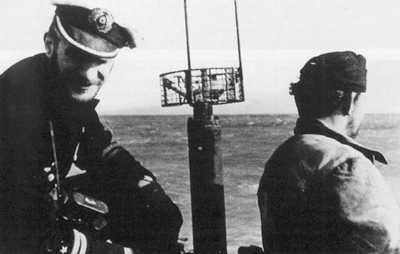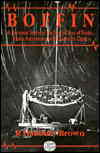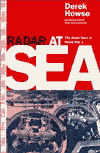U-boat Radar Detectors
prepared by Emmanuel Gustin
FuMB 1 Metox 600A
Installed in U-boats from August 1942 onwards, this was a receiver, tuned to pick up 1.5 meter ASV radar at a safe distance. It was named after its (French!) manufacturer. A Wellington equipped with ASV Mk.I fell into German hands in the summer of 1941, in North Africa, and this revealed the secrets of the radar.
However, the U-boats were soon receiving an excessive number of contacts, and the Navy asked Dr. Runge of Telefunken to investigate. He found that Metox did not sufficiently discriminate between signals. For example it would report a Luftwaffe transmitter on a base near Bordeaux, at distances up to 80km. Metox was modified, but it had already caused considerable trouble. (Sadly, Pritchard does not give dates for these events.)
Metox also emitted a weak signal, a property common to many radio receivers, especially superheterodyne receivers. In an indirect way, this had serious consequences. In the spring of 1943, the U-boats suffered badly because of the introduction by the British of a 10cm ASV radar. But a captured British officer told the Germans that their misfortunes were caused by the transmission of Metox, which were detected by Coastal Command aircraft. After verifying that this was technically possible, the Germans believed the story. This delayed the introduction of Naxos by some months, during which the U-boats suffered heavy losses.
FuG 350 Naxos I
FuG 350a Naxos Ia
Centimetric ASV radar was first used (in an experimental installation) against submarines on 17 March 1943. Metox did not detect these wavelengths, so that surprise attacks on U-boats were once again possible. Within a few weeks aircraft equipped with ASV Mk.III radar made the Bay of Biscay very unsafe for U-boats. By May 1943, Dönitz was aware of the seriousness of the situation, although he still believed that it was caused by emissions of the Metox receivers. Actually, clear evidence had been presented to the Germans when a Stirling bomber carrying a 10cm H2S radar crashed near Rotterdam, in the Netherlands, on 2 February; but apparently this information was slow to reach the Kriegsmarine.

All excellent shot of the Naxos detector. Seen here on U-952 under
command of Kapitänleutnant Oscar Curio.
The Naxos radar warning receiver was built by Telefunken, using components of the FuG 25 Zwilling IFF equipment. It operated between 2500MHz and 3750MHz (wavelengths of 12cm to 8cm), with a detecting range against H2S and its ASV derivatives of about 8km, thanks to a sensitive detector and a multi-stage amplifier. Actually it was too sensitive and caused unneccessary dives by U-Boote. The first Naxos receiver was tested in an aircraft on 11 September 1943. Development had been delayed by an air attack on the Telefunken works.
The original Naxos I had a vertically polarized antenna, with poor results as the British radars initially used horizontal polarisation. (This seems to have been a case of the German designers being smarter than the British ones, with unfortunate consequences.) Naxos Ia had a triple antenna, with elements crossing each other at 45 degrees to avoid this problem. Over 1000 sets of Naxos I were produced, for U-Boot installations but also for the Luftwaffe, the original customer.
(Later versions of Naxos could indicate the approximate direction of enemy aircraft carrying the radar. But this was useful primarily for aircraft, and probably was not installed in submarines?)
The first Naxos equipment was ready in September 1943. In November 1943, the British became aware that U-Boot contacts were lost as the attacker approached, presumably because it detected the 10cm ASV radar. In reaction, ASV Mk.VI had an attenuator, so that the aircraft could limit the power it radiated and give the false impression that it was not approaching.
Also in late 1943 the development of the 3cm ASV Mk.VII radar was commissioned, in anticipation of the appearance of 'Naxos'. This was a development of versions of H2S radar that operated on 3cm. At the end of the war a 3cm version for the Luftwaffe of Naxos was ready, but only about 100 were constructed. If the war had continued, they could, and probably would, have been fitted to new submarines.
Aphrodite
Aphrodite was a decoy balloon. Filled with hydrogen, it floated a few meters above the water surface, anchored to a floating plate. Aluminium foils attached to the balloon gave a strong radar echo, similar to that of an U-boat on British radar screens.
Devices not covered here include Wanze, Fliege, Bali, Samon and others.
Sources
- The Radar War -- Germany's Pioneering Achievement 1940-45
David Pritchard, published by Patrick Stephens Limited, 1989. - Avionics -- The Story and technology of aviation electronics Bill Gunston, published by Patrick Stephens Limited, 1990.
- The Tsetse and the U-boat
Roy Nesbit, in Aeroplane Monthly, May and June 1991.
Selected media links
|
|
|






